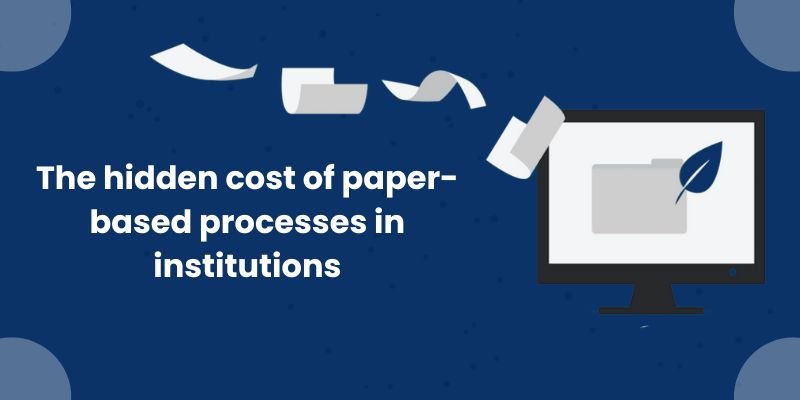In an era defined by digital speed and seamless connectivity, many institutions – from educational organizations and healthcare systems to government departments and private enterprises – still rely heavily on paper-based processes.
At first glance, paper seems familiar, dependable, and tangible. But what’s often overlooked is the complex web of hidden costs that come with continuing to use physical documentation systems in a digital world.
These costs are not just financial. They affect time, efficiency, data security, sustainability goals, and even institutional reputation.
1. The Productivity Black Hole
Paper processes are slow — there’s no two ways about it. Staff often spend a disproportionate amount of time locating, filing, duplicating, and verifying physical documents. Worse still, when a document is misfiled or lost, it can take days (or longer) to resolve the issue.
Consider these scenarios:
- A teacher searching through cabinets for a student’s medical form.
- A nurse manually updating patient files between departments.
- An HR officer scanning hundreds of application forms.
All of these are common — and all are preventable.
Digital systems drastically reduce the time and mental energy required to perform routine tasks. With cloud-based storage, document retrieval becomes instant. Automation tools can sort, verify, and flag data without human error.
Over time, the hours saved compound into weeks, months — even full-time salaries reclaimed from administrative drag.
2. Operational Costs that Add Up Quietly
Institutions often underestimate the real cost of managing paper.
Here’s what’s usually involved:
- Stationery: Paper, envelopes, folders, ink, staplers, binders.
- Hardware: Printers, photocopiers, fax machines, shredders.
- Maintenance: Repairs, toner replacements, service contracts.
- Storage: Physical space, cabinets, and even off-site warehousing.
- Labor: Time spent on manual filing, scanning, photocopying, and archiving.
What looks like “low-cost” often snowballs into significant overhead, especially when scaled across departments or multiple campuses.
By comparison, digital tools may require an upfront investment, but their long-term ROI in reduced expenses and increased productivity is consistently higher.
3. Data Security and Compliance Risks
With rising concerns around data privacy and regulatory compliance (think GDPR, HIPAA, RTI, etc.), institutions can’t afford to be lax about how they manage information.
Paper records are inherently fragile:
- Easily misplaced or mishandled.
- Vulnerable to fire, floods, and pests.
- Difficult to audit or track access history.
- Prone to unauthorized viewing or tampering.
Digital systems, when properly implemented, offer encryption, access control, backup redundancy, and audit trails — all critical for maintaining data integrity and building trust with stakeholders.
Moreover, having digitized records makes compliance reporting faster, more accurate, and less stressful.
4. Lack of Transparency and Accountability
Paper trails are opaque.
When a document moves from hand to hand, there’s little visibility into who accessed it, when, and why. This can create bottlenecks, enable miscommunication, or even facilitate malpractice.
For example:
- Who approved the leave form?
- When was the invoice submitted?
- Was the file updated with the latest information?
Digital systems allow for real-time tracking, collaboration, and reporting. Tasks can be assigned, deadlines set, and accountability built in — with clear data trails that support transparent governance.
In institutions where decisions affect hundreds or thousands of people, that kind of clarity is not just useful — it’s essential.
5. Environmental Impact — The Silent Contributor
While discussions around sustainability are now central to most institutional strategies, many overlook how deeply paper dependence contributes to environmental degradation.
The production of paper:
- Requires large quantities of water and energy.
- Contributes to deforestation and loss of biodiversity.
- Produces significant waste and carbon emissions.
And what happens after use? Most institutions don’t have robust recycling processes. Documents pile up in storage rooms or end up in landfills.
By reducing paper reliance, institutions take an actionable step toward climate responsibility — and demonstrate genuine commitment to their ESG (Environmental, Social, Governance) values.
The Case for Digital Transformation
So what does going digital look like?
- Cloud-based file storage
- Digital forms and signatures
- Workflow automation tools
- Online portals for student/patient/staff interactions
- Centralized data dashboards
- Real-time communication and collaboration platforms
These solutions don’t just cut costs — they enable better decisions, faster service delivery, improved stakeholder experience, and future-ready scalability.
Even hybrid models (part-paper, part-digital) can significantly improve operations when designed thoughtfully.
Clinging to paper in a digital world is like using a typewriter in the age of AI.
Institutions that shift from paper to digital systems are not only reducing operational waste — they’re unlocking new levels of agility, transparency, and impact.
Yes, change can be challenging. But so is wasting time, money, and resources on outdated systems.
The real question isn’t can we afford to go digital?
It’s, can we afford not to?












